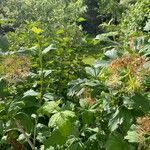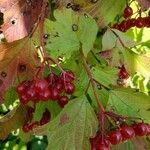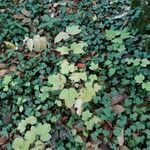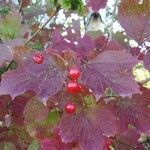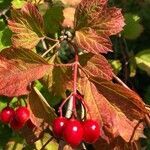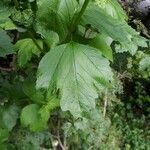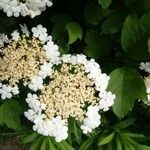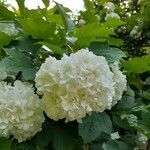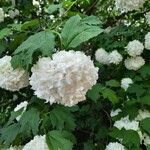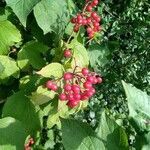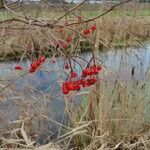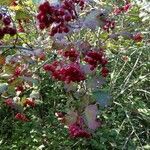Shrubs, deciduous, to 6 m tall. Bark dark gray, thin or thick, corky or not. Branchlets of current year green-brownish, sometimes reddish, glabrous or pubescent, with conspicuously raised lenticels; branchlets of previous year yellowish or red-brown, terete, glabrous, with dispersed, small, rounded lenticels. Winter buds ovoid, stipitate, 4-6 mm, with 2 pairs of connate scales, inner scales membranous, base connate into a tube; scales glabrous. Leaves always opposite, not clustered at apices of branchlets; stipules 2, persistent, subulate, 1-5 mm; petiole green or reddish, robust, 1-5 cm, glabrous or pubescent, with 2-4 or more discoid glands near apex; leaf blade green when young, orbicular-ovate to broadly ovate or obovate, 6-12 × 5-10 cm, papery, abaxially spreading hairy especially on veins and vein axils, adaxially almost glabrous, midvein raised abaxially, 3-palmatinerved, veins straight or slightly arched, branched, ending in teeth, conspicuously raised abaxially, impressed adaxially, veinlets transverse, slightly raised abaxially, impressed adaxially, usually 3-lobed, leaves at apices of branches sometimes undivided, base rounded, truncate, or shallowly cordate, without glands, middle lobe often largest, margin irregularly dentate, apices of lobes acute, lateral lobes present, sometimes slightly spreading toward outside. Leaves on upper part of branchlets often narrow and longer, elliptic to oblong-lanceolate and not divided, margin sparsely crenate or shallowly 3-lobed; lobes entire or subentire, lateral lobes short, middle lobes elongated. Flowers appearing after leaves; inflorescence a compound umbel-like cyme, terminal, 5-12 cm in diam.; rays whorled; first node of inflorescence with 6-8 rays, dense, glabrous or with simple hairs, with 5-10 large sterile radiant flowers, or totally composed of large sterile flowers; peduncle robust, 2-5 cm, glabrous or pubescent; bracts and bracteoles deciduous, leaflike, green, lanceolate, glabrous or sparsely hairy. Flowers on rays of 2nd and 3rd orders, not fragrant, very shortly pedicellate. Sterile flowers: calyx like fertile flowers, corolla white, 1.3-2.5 cm in diam., long pedicellate; lobes broadly obovate, apex rounded, unequally shaped; stamens and pistils not developed. Fertile flowers: calyx green; tube obconical, ca. 1 mm, glabrous; lobes triangular, ca. 0.6 mm, glabrous, apex obtuse; corolla white, rotate, 4-5 mm in diam., outside glabrous, inside pubescent; tube 1-2 mm; lobes spreading or reflexed, suborbicular, 1-1.5 mm, slightly unequal in size, apex rounded, margin entire; stamens conspicuously exceeding corolla, inserted near base of corolla; filaments ca. 4 mm; anthers yellow-whitish, or purple, ca. 1 mm; styles slightly exceeding calyx lobes; stigmas 2-lobed. Fruit initially turning yellow, maturing red, suborbicular, 8-10(-12) mm in diam., base rounded, apex rounded, glabrous; pyrenes compressed, subglobose, 7-9 mm in diam., without grooves, apex rounded. Fl. May-Jun, fr. Sep-Oct. 2n = 18*.
More
A shrub. It grows 3-4.5 m tall and spreads 2.5-3.7 m wide. It is larger than the North American cranberry. It loses its leaves during the year. There are saucer like glands on the leaf stalk. The leaves are maple like. The flowers are white and occur in heads. Small fertile flowers are surrounded by larger infertile flowers. The fruit are red and occur in bunches. The fruit are bitter and remain on the tree over winter.
